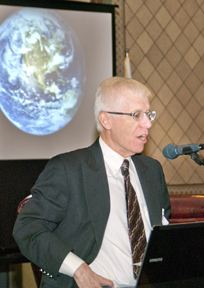Images of shrinking glaciers and stranded polar bears give powerful evidence of the need for people to work together on the common problem of protecting the planet. Adding art and the voices of community leaders to the data scientists are compiling may help convince decision makers to take action to deal with climate change, said Jonathan Samet, director of the USC Institute for Global Health.
Samet spoke on challenges and opportunities in arts and health care and the need for stewardship of the planet at an Earth Day Forum on April 22 at Los Angeles City Hall.

Jonathan Samet, director of the USC Institute for Global Health, spoke of the need for stewardship of the planet at an Earth Day Forum at Los Angeles City Hall. Photo/Richard Fukuhara
The forum, “Aging People/Aging Planet: The Face of Climate Change—Local and Global Perspectives,” was the USC Institute for Genetic Medicine Art Gallery’s seventh annual Global Environment Forum. It was organized by a steering committee chaired by Muriel Wood and BK Rao in collaboration with Sister Cities of Los Angeles Inc. and the gallery’s public, private, nonprofit/faith-based, academic and media partners.
Pointing to examples of air pollution from traffic in Beijing and from indoor cooking fuels and diesel vehicles in Addis Ababa, Ethiopia, Samet said, “Now, the air pollution of Beijing and Addis is everyone’s problem—in our global world. At 7 billion, we have exceeded the absorptive capacity of the planet, polluting one of our global commons—the atmosphere.”
Yet Samet, the Flora L. Thornton Chair of the Department of Preventive Medicine in the Keck School of Medicine of USC, said he remains optimistic.
“The move to green energy technology will make a difference,” he said. “Already, the market is responding to the climate crisis with carbon-free strategies for energy production and for saving energy. New fuel efficiency standards and public preferences have already begun to shift the vehicle industry—from SUVs to hybrid and electric vehicles. People will continue to make the right choice, if they have that option.
“I have confidence that people will unite around a common goal of saving our planet,” he said. “They know that we may be able to procrastinate for a while, but inherently, we all want a better world for our children and grandchildren.”
Samet spoke on one of three panels presenting health, international and private sector perspectives. The international panelists came from the consulates of Bhutan, Canada, Egypt, France, Germany, Israel, Mexico and New Zealand.
As they entered the forum, participants viewed works from the exhibition “Aging People/Aging Planet” by artists Mary Lou Dauray and Orna Makleff. Basso Profundo KB Solomon, artist-in-residence at the USC Dornsife School’s Office of Religious Studies, performed the national anthem and “Dream the Impossible Dream.” The exhibition runs through June 26 in the second floor art gallery at the USC Institute for Genetic Medicine, 2250 Alcazar St., on the USC Health Sciences campus.

